 Army Sgt. Michael Davis, a truck driver with the Georgia Army National Guard's 1148th Transportation Company, looks for oncoming traffic while exiting an Interstate 95 offramp in North Carolina. Davis was part of a convoy hauling ammunition and supplies during Operation Patriot Bandoleer, which sees to the movement of thousands of tons of munitions and materials in support of Army Sustainment Command. Soldiers from the 1148th Trans. Co. covered more than 1,600 miles, traveling from Georgia to Pennsylvania and back over the course of a week.
Army Sgt. Michael Davis, a truck driver with the Georgia Army National Guard's 1148th Transportation Company, looks for oncoming traffic while exiting an Interstate 95 offramp in North Carolina. Davis was part of a convoy hauling ammunition and supplies during Operation Patriot Bandoleer, which sees to the movement of thousands of tons of munitions and materials in support of Army Sustainment Command. Soldiers from the 1148th Trans. Co. covered more than 1,600 miles, traveling from Georgia to Pennsylvania and back over the course of a week.
On the road again: Georgia Army Guard unit hauls ammo, supplies as part of Operation Patriot Bandoleer
Story and photos by Sgt. 1st Class Jon Soucy
National Guard Bureau
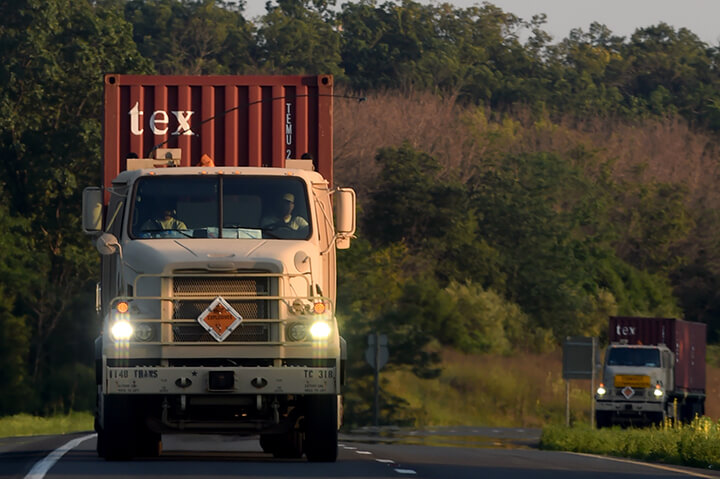 Soldiers from the 1148th Transportation Company make their way along Interstate 81 in Virginia as they head toward their destination in Pennsylvania during Operation Patriot Bandoleer.
Soldiers from the 1148th Transportation Company make their way along Interstate 81 in Virginia as they head toward their destination in Pennsylvania during Operation Patriot Bandoleer.
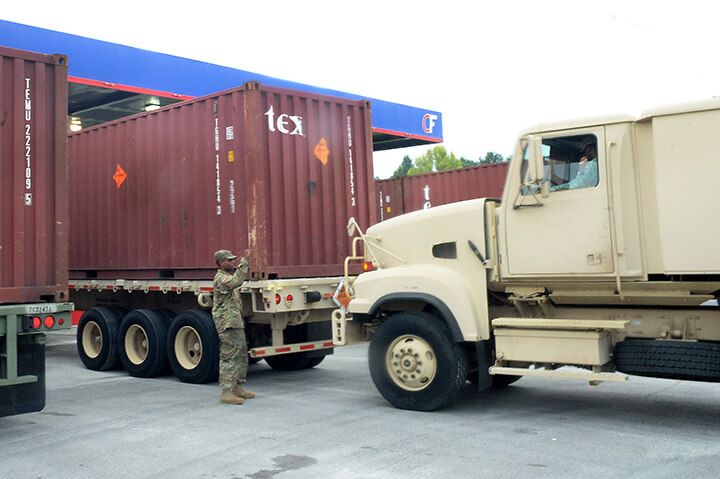 Army Sgt. Charles Wallace, a driver with the unit, directs the driver of a another truck as he pulls into a fuel point. Maneuvering in confined areas such as truck stops and fuel points is one of the challenges during the convoy, said unit members. In those situations, the co-driver exits the vehicle to act as a ground guide for added safety.
Army Sgt. Charles Wallace, a driver with the unit, directs the driver of a another truck as he pulls into a fuel point. Maneuvering in confined areas such as truck stops and fuel points is one of the challenges during the convoy, said unit members. In those situations, the co-driver exits the vehicle to act as a ground guide for added safety.
FORT GORDON, Ga. — The low, chattering grumble of diesel engines broke the early morning stillness as the Soldiers checked their tractor-trailer trucks. Trailer connections were gone over, loads were inspected and fluid levels topped off as the "Road Dawgs" of the Georgia Army National Guard's 1148th Transportation Company prepared to hit the road.
"When folks need stuff moved long distance, we're the ones to call," said Army Capt. Derek Ellyson, commander of the unit.
Dwarfed by their trucks and trailers – which were lined up end to end in the staging area, seemingly stretching to the horizon – the Soldiers went about the business of readying the convoy of more than 20 trucks. By the end of the day, they would find themselves more than 500 miles away from where they started, adding to the roughly 300 miles they traveled the day before.
The mission was part of Operation Patriot Bandoleer, which sees to the movement of thousands of tons of ammunition, munitions and supplies in support of Army Sustainment Command.
"[The Army] moves ammo all around the world to keep ready ammo in certain places and rotate ammo that needs to be serviced, maintained or de-milled or just used for training," said Ellyson. "Right now, what we're doing is just rotating some of that ammo…and we're moving it back into the maintenance and training pipelines."
The overall mission involves Soldiers from throughout the Army National Guard and this year marks the third year Soldiers from the 1148th Trans. Co. have taken part in the mission.
"I love it," said Army Sgt. Michael Davis, a truck driver with the unit. "I think it's a pretty cool mission. It gives some of the younger Soldiers the experience of driving on the open road and handling the different materials that we're hauling."
For Davis, who did two deployments to Iraq and one to Afghanistan, the mission also ties into one of the things he loves about being a truck driver.
"You can't beat this," he said. "You get to see different things, different places. I've never had any other desire to do anything else in the Army."
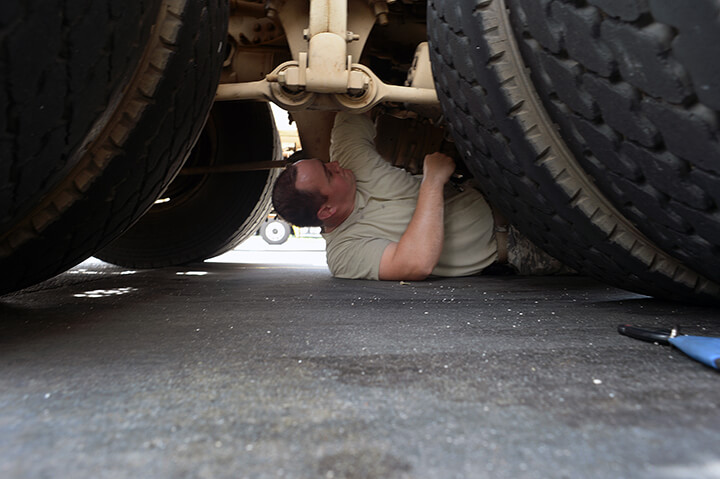 Army Sgt. Richard Johnson, a driver with the unit, replaces a rubber seal on the air brakes of his truck during a fuel stop in South Carolina. Maintenance is one of the keys to success, said unit members, and the ability to fix small issues on the road keeps the convoy moving.
Army Sgt. Richard Johnson, a driver with the unit, replaces a rubber seal on the air brakes of his truck during a fuel stop in South Carolina. Maintenance is one of the keys to success, said unit members, and the ability to fix small issues on the road keeps the convoy moving.
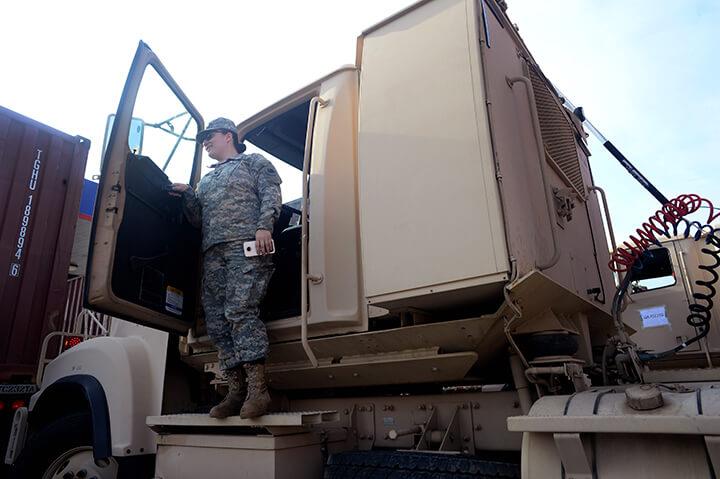 Spc. Michaela Schiesser, a driver with the unit, steps out from the cab of her truck after pulling into a fuel stop. With a driver and co-driver in each truck, having a balance of strengths is what makes a strong team in the cab, she said. Schiesser's abilities behind the wheel complement areas where her co-driver isn’t as strong, she said, adding that his strengths fill areas she is weaker in and together they "even each other out and watch out for each other and help each other."
Spc. Michaela Schiesser, a driver with the unit, steps out from the cab of her truck after pulling into a fuel stop. With a driver and co-driver in each truck, having a balance of strengths is what makes a strong team in the cab, she said. Schiesser's abilities behind the wheel complement areas where her co-driver isn’t as strong, she said, adding that his strengths fill areas she is weaker in and together they "even each other out and watch out for each other and help each other."
Planning for the mission – which saw the unit travel more than 1,600 miles from Georgia to Pennsylvania and back over the course of a week – can be intensive
"It's basically a miniature deployment," said Ellyson. "You've got all hands on deck. So, think of all the things that go into a deployment and we do that here."
Ellyson recently took command of the unit, coming on board just before the start of the mission, and planning was instrumental.
"That's where the noncommissioned officers are key," he said. "They put a lot of work into planning this and getting ready. They understand that preparation is what makes you successful. It's not necessarily your actions on the objective, it's your planning for your actions on the objective."
Ellyson said that even with all the planning, he felt anxious as the mission kicked off and Soldiers pulled out from their homestation at Fort Gordon
"I was a ball of nervous energy," he said. "Then I watched the NCOs kick into action and I was like 'you can probably stop being worried now."
Ellyson also had nothing but praise for the Soldiers in the unit and he emphasized the unit's success at executing a mission with multiple moving parts.
"I pulled everybody together [at the first stop point] and just said 'Hey, I'm proud of you,' he said. 'You got everybody up here quickly and safely. I need you to keep that initiative and keep that up because you all are knocking it out of the park'."
For Spc. Michaela Schiesser, who has taken part in previous Patriot Bandoleer missions, that success and motivation is just part of how the unit works.
"When we have a mission, we all do what needs to be done no matter what needs to happen," she said, adding that a big help came from the unit's maintenance section.
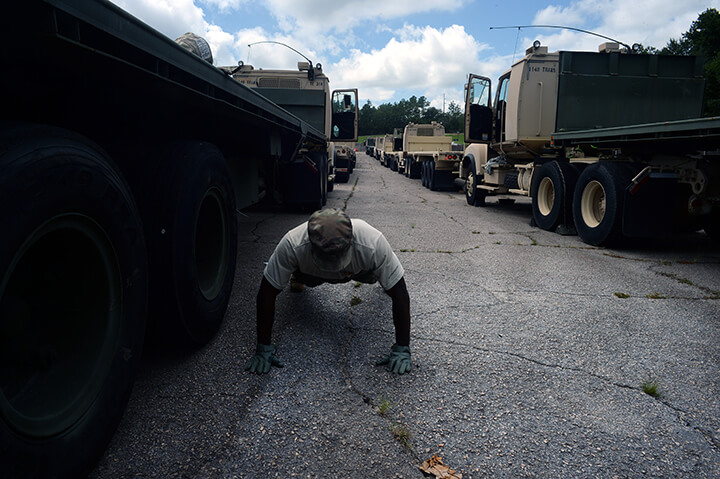 Army Sgt. Charles Wallace, a driver with the unit, takes a break from readying his truck for the convoy to knock out 50 push-ups. Physical fitness is important, even on the road, said Wallace, adding that he does 50 push-ups once an hour while in the motor pool area, and plans on doing at least that many at each rest stop along the way.
Army Sgt. Charles Wallace, a driver with the unit, takes a break from readying his truck for the convoy to knock out 50 push-ups. Physical fitness is important, even on the road, said Wallace, adding that he does 50 push-ups once an hour while in the motor pool area, and plans on doing at least that many at each rest stop along the way.
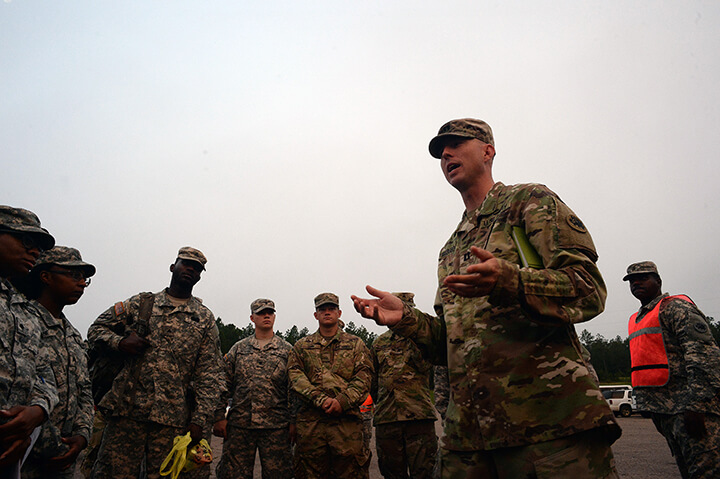 Army Capt. Derek Ellyson, center, the unit commander, gives a pep talk to Soldiers in the unit while taking part in the convoy. "I'm proud of you," he said. "You got everybody up here quickly and safely. I need you to keep that initiative and keep that up because you all are knocking it out of the park."
Army Capt. Derek Ellyson, center, the unit commander, gives a pep talk to Soldiers in the unit while taking part in the convoy. "I'm proud of you," he said. "You got everybody up here quickly and safely. I need you to keep that initiative and keep that up because you all are knocking it out of the park."
"Maintenance, who are fabulous human beings, worked non-stop to get us ready," Schiesser said.
Spending time with the maintenance section also helps her out as a driver, she said.
"I like learning and you can only learn so much about the [truck] from just driving," said Schiesser. "Hanging out with maintenance definitely helps out because you get to find out which things break easier and what not to do and what to do in different situations."
But while on the road, it's finding a balance between driver and co-driver that makes for a strong team in the cab, Schiesser said.
"[My co-driver] is strong when it comes to parking," she said. "He can park like a pro. But, maintaining his intervals [between trucks] and using the engine brake, he's not so good at. I'm very good at maintaining intervals and using the engine brake, but not parking. So, we even each other out and watch out for each other and help each other."
Getting to know the individual truck is also key.
"Every truck is different," said Cpl. Tonya Tapia, a driver with the unit. "You have to get the feel of it."
That becomes tantamount when hauling a load, especially while negotiating hills and curves.
"If we have containers on the back and you make a turn, you can tell. You can feel the weight shifting," she said. "Once you get used to the load being there, it's just like driving a car."
But there are differences between driving a semi-truck and driving a car.
"Sometimes after getting out of one of these and then driving a car I'll make really wide turns," said Davis. "I have to remember that I don't need to make wide turns like that in a car."
Others in the unit agreed.
"It's different when you're driving a car," said Staff Sgt. Steven Allen, a driver with the unit. "You've got your radio on and you're comfortable and you can just drive. With these trucks, you've got to maneuver in traffic and it's always a challenge."
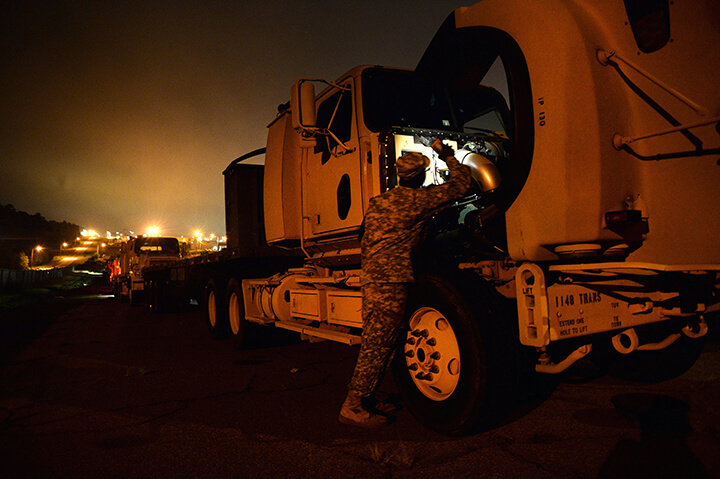 Spc. Craig Elliott, a driver with the unit, performs preventative maintenance checks on his truck prior to heading out from the unit motor pool area at Fort Gordon, Ga.
Spc. Craig Elliott, a driver with the unit, performs preventative maintenance checks on his truck prior to heading out from the unit motor pool area at Fort Gordon, Ga.
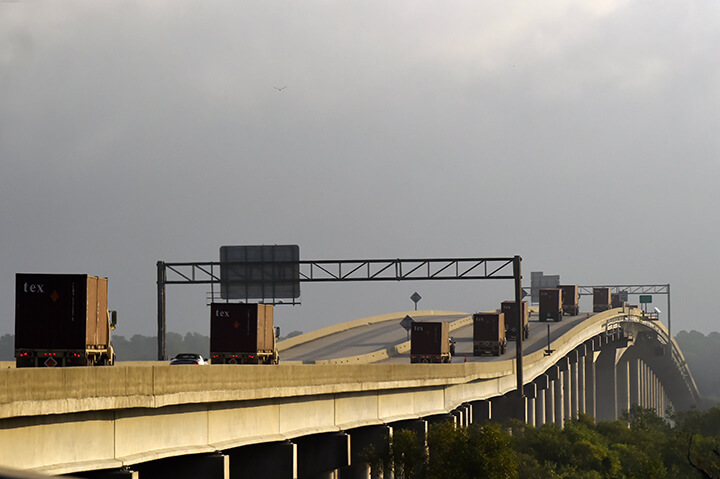 Soldiers with the 1148th Transportation Company cross over the Cape Fear River near Wilmington, N.C., as they convoy north toward Pennsylvania.
Soldiers with the 1148th Transportation Company cross over the Cape Fear River near Wilmington, N.C., as they convoy north toward Pennsylvania.
Davis found similar challenges with highway traffic.
"You've got to pay attention to what you're doing," he said. "You've got civilian vehicles out here. Our trucks don't go as fast and you've got people in some vehicles that want to go ahead and that's when your accident avoidance comes into play. Sometimes they forget that we can't stop as fast as they can."
Other challenges come while maneuvering in confined areas, such as truck stops and fuel points.
"One of the biggest challenges is going into the fuel stops," said Davis, adding that in those situations the co-driver exits the truck to act as a ground guide for added safety.
"If you're paying attention to what you're doing, and the driver and [co-driver] are on the same page, everything will run smooth," he said.
As the miles rolled by and the unit delivered its cargo, some were already looking to next year's mission.
"When this mission ends, we're going to start planning for next year pretty much the very next day," said Ellyson. "It takes that much planning."
It also means incorporating lessons learned from this year's run.
"We've identified a few shortcomings already and correcting little things like that makes a big difference next time," said Ellyson, adding that the larger focus is building a positive legacy for the future.
"The tasks we complete every day, that's just stuff we do every day," he said. "But what we do to enable the Soldiers and the unit to be successful after we're gone, that's our legacy. We, as leaders in the Army, need to be focused on building a legacy, even as a private. What can we do for the people who come after us?"
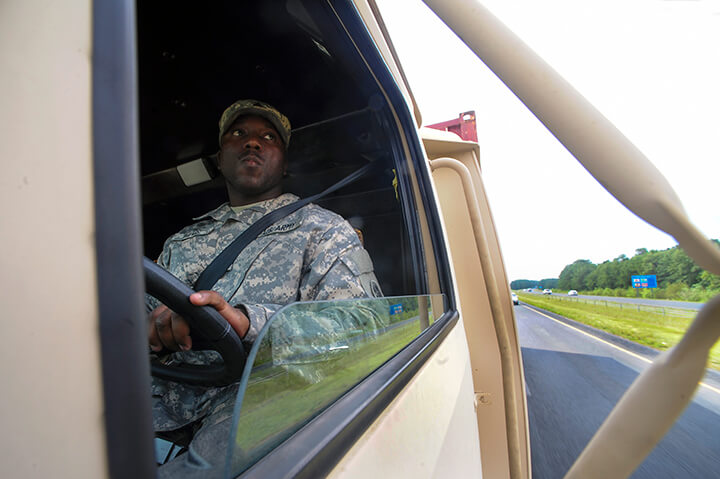 Davis checks his mirrors while driving through North Carolina on Interstate 95. Maintaining awareness of traffic around the truck is one of the key elements of safe driving, he said, adding that sometimes other vehicle drivers "forget that we can’t stop as fast as they can."
Davis checks his mirrors while driving through North Carolina on Interstate 95. Maintaining awareness of traffic around the truck is one of the key elements of safe driving, he said, adding that sometimes other vehicle drivers "forget that we can’t stop as fast as they can."
Those who took part in previous Patriot Bandoleer missions set things up that allowed for continued success moving forward, said Ellyson.
"The NCOs and officers who came before and did that planning left a pretty good legacy," said Ellyson.
Others agreed.
"I wouldn't want to do this with anybody else but these guys," said Schiesser.